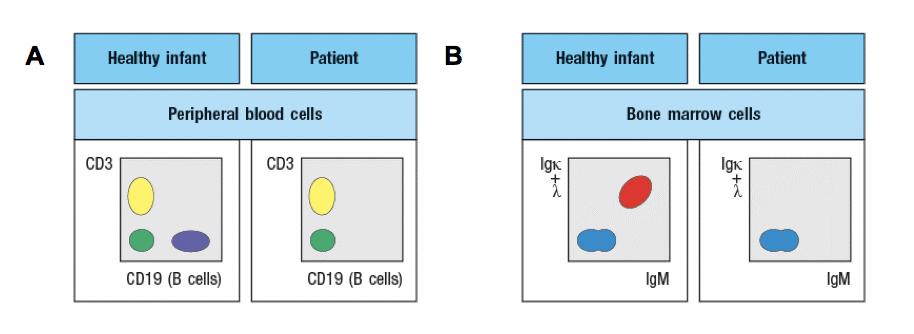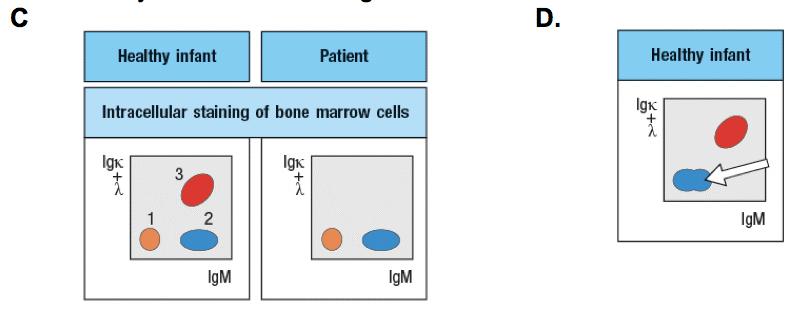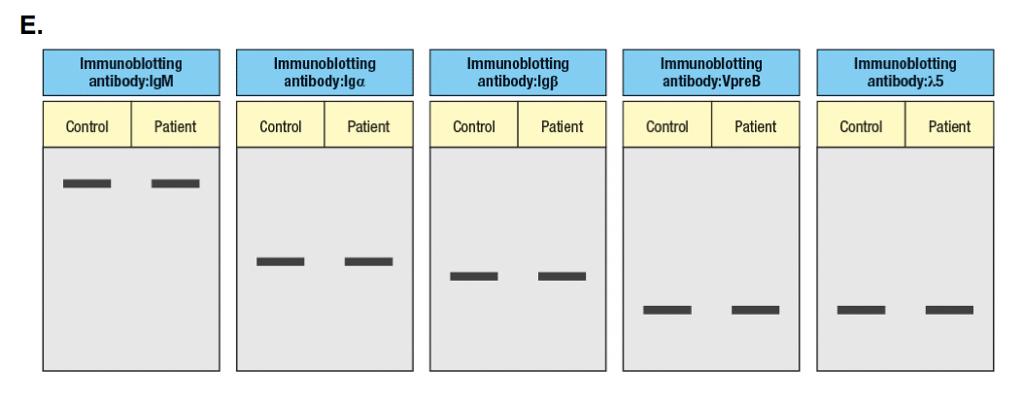An infant is admitted to the hospital with a history of recurrent and persistent bacterial infections. His physician suspects he has an immunodeficiency disease, and
An infant is admitted to the hospital with a history of recurrent and persistent bacterial infections. His physician suspects he has an immunodeficiency disease, and obtains a sample of the patient’s peripheral blood. The white blood cells are analyzed by antibody staining followed by flow cytometry, and the results are shown in figure A on the left. To determine the origin of the peripheral blood cell defect, a bone marrow biopsy is taken from the patient and compared to a healthy control, as shown in figure B on the right.
 To obtain additional information, bone marrow cells are treated with a chemical that permeabilizes the cell membrane, allowing antibodies to enter the cells and bind to their target antigens within the cells, a technique known as ‘intracellular staining’. The results of this analysis are shown in figure C.
To obtain additional information, bone marrow cells are treated with a chemical that permeabilizes the cell membrane, allowing antibodies to enter the cells and bind to their target antigens within the cells, a technique known as ‘intracellular staining’. The results of this analysis are shown in figure C.

a). What are populations 1, 2, and 3 in Figure C? Explain your reasoning (just a few words should be sufficient).
b). In another experiment, the expression of proteins on the surface of cells from a healthy infant are also examined. What is the population of cells that are IgMloIgknegIglneg, as indicated by the arrow in figure D? Explain your reasoning.
c). Based on these data, where (in terms of the stages of B cell development) does the defect seem to be occurring? Based on the events that occur in the different stages, explain what you think is most likely causing the block between these stages
To help further identify the defective or missing protein in the patient’s developing B cells, bone marrow cells are isolated and protein lysates are prepared for Western blots. A series of antibodies are tested and the results are shown in figure E.
 d). Given the results from the Western blots shown above, what is the most likely candidate molecule (or type of molecule) responsible for the patient’s immunodeficiency disease? Explain your reasoning.
d). Given the results from the Western blots shown above, what is the most likely candidate molecule (or type of molecule) responsible for the patient’s immunodeficiency disease? Explain your reasoning.
A Healthy infant Patient B Healthy infant Patient Peripheral blood cells Bone marrow cells CD3 CD3 Igk Igk CD19 (B cells) CD19 (B cells) IgM IgM
Step by Step Solution
3.54 Rating (158 Votes )
There are 3 Steps involved in it
Step: 1
a Human population 1 is cells that produce both low levels of IgM and Igk Both of these antibodies i...
See step-by-step solutions with expert insights and AI powered tools for academic success
Step: 2

Step: 3

Ace Your Homework with AI
Get the answers you need in no time with our AI-driven, step-by-step assistance
Get Started


